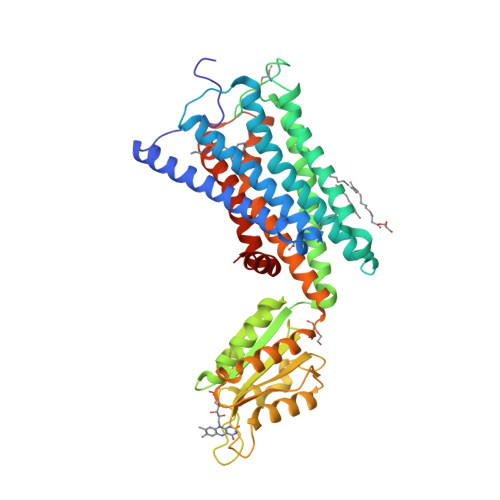Crystal Structure of the Human Cannabinoid Receptor CB1.
Hua, T., Vemuri, K., Pu, M., Qu, L., Han, G.W., Wu, Y., Zhao, S., Shui, W., Li, S., Korde, A., Laprairie, R.B., Stahl, E.L., Ho, J.H., Zvonok, N., Zhou, H., Kufareva, I., Wu, B., Zhao, Q., Hanson, M.A., Bohn, L.M., Makriyannis, A., Stevens, R.C., Liu, Z.J.(2016) Cell 167: 750-762.e14
- PubMed: 27768894
- DOI: https://doi.org/10.1016/j.cell.2016.10.004
- Primary Citation of Related Structures:
5TGZ - PubMed Abstract:
Cannabinoid receptor 1 (CB 1 ) is the principal target of Δ 9 -tetrahydrocannabinol (THC), a psychoactive chemical from Cannabis sativa with a wide range of therapeutic applications and a long history of recreational use. CB 1 is activated by endocannabinoids and is a promising therapeutic target for pain management, inflammation, obesity, and substance abuse disorders. Here, we present the 2.8 Å crystal structure of human CB 1 in complex with AM6538, a stabilizing antagonist, synthesized and characterized for this structural study. The structure of the CB 1 -AM6538 complex reveals key features of the receptor and critical interactions for antagonist binding. In combination with functional studies and molecular modeling, the structure provides insight into the binding mode of naturally occurring CB 1 ligands, such as THC, and synthetic cannabinoids. This enhances our understanding of the molecular basis for the physiological functions of CB 1 and provides new opportunities for the design of next-generation CB 1 -targeting pharmaceuticals.
Organizational Affiliation:
iHuman Institute, ShanghaiTech University, Shanghai 201210, China; National Laboratory of Biomacromolecules, Institute of Biophysics, Chinese Academy of Sciences, Beijing 100101, China.





















